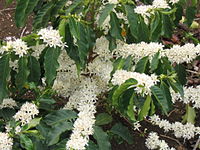
Photo from wikipedia
The traceability of the geographical origin of coffee is a challenging issue to protect producers and consumers from the risk of fraud. A total of 162 Arabica from Peru, Colombia… Click to show full abstract
The traceability of the geographical origin of coffee is a challenging issue to protect producers and consumers from the risk of fraud. A total of 162 Arabica from Peru, Colombia and Brazil, and Robusta from India, Vietnam and Uganda, espresso coffee (EC) samples of different degrees of roasting (light, medium and dark) were characterized for physico-chemical features (lipids, solids, and chlorogenic acids) and analyzed via SHS-GC/MS analysis, with the aim of discriminating the samples according to their geographical origin. Linear discriminant analysis (LDA), performed on the data of the chemical classes of the volatile organic compounds (VOCs), was able to correctly identify 97.53% of the tested samples through cross-validation. The dark roasting of the coffee beans implied a higher quantity of volatile compounds in the headspace of the EC, belonging to chemical classes of furans, esters, N-heterocyclic and sulfur compounds, reducing the differences by geographical origin. Light- and medium-roasted Robusta EC showed a major contribution of pyrazines and pyrimidines, while aldehydes, alcohols and ketones were generally more representative in Arabica samples. The quantitative distribution of volatile compounds proved to be a useful tool to discriminate samples by geographical origin.
Journal Title: Applied Sciences
Year Published: 2023
Link to full text (if available)
Share on Social Media: Sign Up to like & get
recommendations!